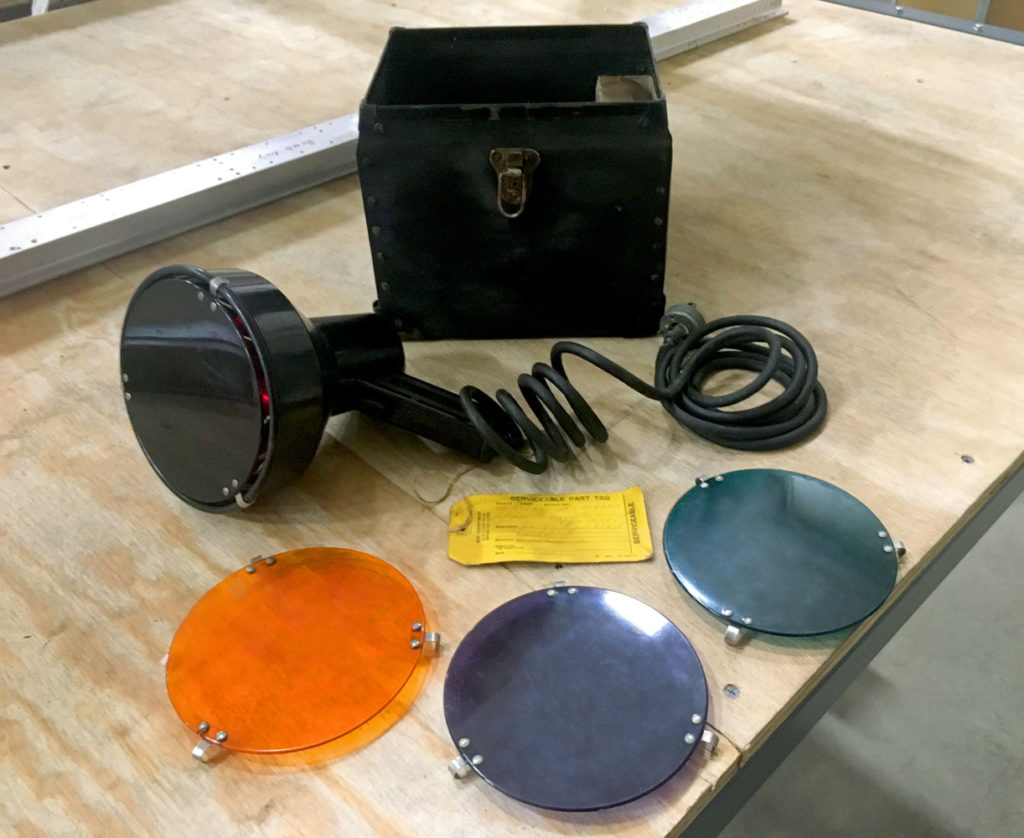
Grimes C-3 Aldis Signal Lamp Kit.
As I mentioned in my last post, I recently returned from this year’s 384th Bomb Group reunion in Dayton, Ohio. It was there that the foundation’s photographer and historian, Keith Ellefson, graciously offered to donate his Aldis Lamp in memory of his late uncle, Raymond O. Wisdahl.
Born to Norwegian immigrants, Wisdahl joined the Army Air Forces at age 19, being assigned to the 384th Bomb Group on 17 July 1944 as part of a replacement aircrew. Wisdahl’s crew was as follows:
CPT Roy A. Vinnedge
Texas
1 August 1916 – 17 January 1964
Pilot
Age 27.
2LT Hebert H. Schaaf
Ohio
25 February 1920 – 16 March 2008
Co-Pilot
Age 24.
2LT Clarence C. Hightshoe
Iowa
26 December 1920 – 9 January 2016
Navigator
Age 23.
2LT Jack D. Roberts
Illinois
12 May 1923 – 12 May 2015
Bombardier
Age 21.
TSGT Lester A. Walcott
Michigan
17 February 1924 – 7 July 2006
Top Turret
Age 20.
TSGT Stanley T. Burek
Michigan
12 April 1916 – 9 June 1991
Radio Operator
Joined at age 28.
SSGT Raymond O. Wisdahl
North Dakota
9 May 1923 – 21 Mar 1997
Ball Turret Gunner
Age 21.
SSGT Lorin A. Dunham
Iowa
27 July 1921 – 31 May 2005
Waist Gunner
Age 22.
SSGT Frank W. Rock
New Hampshire
26 February 1921 – 25 November 1997
Waist Gunner
Age 23.
SSGT Delmar J. Beesley
Indiana
26 February 1920 – 23 March 1945
Tail Gunner
Age 24.
Killed at age 25 aboard Heavenly Body (43-39053)
Flying as a ball turret gunner, Wisdahl successfully completed a full tour-of-duty with the 384th, flying his 35th and final mission on 19 February 1945.

Soldiers of the US Third Army show the crew of Bolo Babe their aircraft’s crash-sight. From left to right: Hightshoe, Schaaf, Beesley, Burek, Rock, Wisdahl, and Wolcott. A local French child can be seen sitting by the top turret.
Wisdahl survived being shot down on his seventh mission, his aircraft, Bolo Babe (42-102601), receiving flak damage during a strike against the synthetic fuel plants of Ludwigshafen, Germany. With the electrical systems out along with one of the engines, the pilot (CPT Joseph G. Hartness, Jr.) wisely nursed the aircraft toward the border, crash-landing near Thionville, France. Splitting into small groups, all ten members of the crew evaded German units long enough to be rescued by US personnel of the 774th Tank Destroyer Battalion. The US Third Army (LTG George S. Patton, Jr.) were besieging the nearby city of Metz at the time, and Thionville itself fell to Allied forces on 11 September 1944.
Note the placement of the ammunition box in the photo above, uncomfortably being located where the Norden bombsight would normally go. This suggests that Bolo Babe did not carry a bombsight this day and that its bombardier, 1LT Maurice J. Simons, served in the capacity of a “toggler” – releasing the bombload in conjunction with the lead bomber. It is worth noting that both the bombardier and navigator were still in the nose upon landing, and that the experience was traumatic enough that Simons refused to fly another sortie despite having only completed 12 combat missions.

The yellow tag in the box with the Aldis Lamp indicates that it was last serviced in March 1944.
Keith’s donation in memory of his uncle is a Grimes C-3 Aldis Lamp Kit.
Grimes Manufacturing was the hub of Urbana, Ohio, and every American combat aircraft built during the war was equipped with at least one light built at this facility. The company’s founder, Warren G. Grimes, entered the aviation world at the behest of Henry Ford, designing lights for the Ford Trimotor in the mid-1920s. Like many of the aviation giants of the period – Sperry, Bendix, Pioneer, etc. – Grimes eventually fell from power, being purchased by Honeywell Aerospace in 1997. Today the field is the sight of the Champaign Air Museum as well as a small café renown for its pies.
Signal lamps had long been used throughout military history as a means of flashing Morse code. The Aldis lamp, named for inventor Arthur Cyril Webb Aldis in 1941, took this a step further, combining a trigger system with a series of colored lenses. These were invaluable in bombardment operations as radio silence was strictly enforced amongst aircrews in the early days of the war lest Axis forces listen and/or track the Allied signals. With an Aldis lamp, aircraft could signal one another messages without the fear of being heard. The B-17’s manual states that these units were originally kept in the nose compartment, being mounted on the bulkhead above and behind the navigator, then later moved to the back of the pilot’s seat. However, we know from veteran interviews that the most common user of the Aldis lamp was the tail gunner, flashing the lamp as means of guiding other aircraft into formation position.
The Aldis lamp uses 24 volts and is fully functional. In fact, Keith tells me that at a previous reunion he witnessed a veteran demonstrate code using this lamp.
We thank Keith for his donation and for the service of his late-uncle.

A radio operator of No. 206 Squadron (RAF Coastal Command) uses an Aldis lamp to signal his formation of Lockheed Hudsons.
